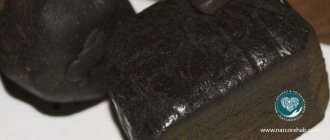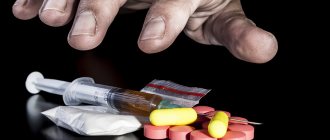Amphetamine drug
Amphetamine is a stimulant type drug. Taking it, a person practically stops feeling tired. The substance is especially popular among clubbers and representatives of creative professions.
What is amphetamine?
Amphetamine is a powerful nervous system stimulant derived from phenylethylamine. It is addictive from the first use, while a person receives a dose of energy and euphoria only the first few times. Subsequently, the body begins to get used to the drug and require more and more doses.
Composition of the substance
Amphetamine is made from drugs containing ephidrine. This substance is present in the ephedra plant. In 1887, the drug was developed in Germany, and since 1932 it has been used in the treatment of mental disorders (phenamine). Hence its modern slang name - hair dryer.
The effect of amphetamine
When this substance enters the body, it causes it to intensively release norepinephrine and dopamine into the blood. The result is a lack of fatigue, unprecedented energy, and increased sexual desire. A person on amphetamine is able to dance or walk for almost a day without a break.
Such a surge of energy is replaced by a sharp loss of strength and a state of mild panic, which gradually increases. In 99 percent of cases, the person goes and administers another dose to relieve the state of fear and panic. A month or two after the start of use, the drug already takes full control of the body.
Photo
Figure: Amphetamine
Properties of the drug
Since this drug has a strong stimulating effect, the internal organs wear out quite quickly. The hormonal system also stops functioning normally.
Amphetamine is most often administered intravenously or snorted. With the first method, the veins can practically rot. Inhalation of the powder causes burns to the mucous membranes of the nose and throat.
Getting used to the drug happens quite quickly. However, during the first time of use, a person can still be saved; it is enough to simply pay attention to some characteristic symptoms.
Methods of using amphetamine
Amphetamine can be consumed in all ways - snorting, smoking, injecting or swallowing. It is believed that the most powerful effect is achieved with an injection. In fact, there is practically no difference - the drug destroys the body equally in any way.
Time of action
The effect of a surge of strength lasts from 15 to 24 hours. Moreover, further withdrawal directly depends on the duration of the drug’s action - the longer it is, the harder it will be for the person.
Where is it contained?
Amphetamine is contained in some pharmaceutical preparations:
- Vyvanse;
- Dexedrine;
- Adderall.
They are mainly used to treat mental disorders.
Treatment prices:
| Service | Price, rub) |
| Types of therapies | |
| Standard detoxification therapy | 3 500 ₽ |
| Double Detox Therapy | 6 000 ₽ |
| Enhanced Detoxification Therapy | 7 500 ₽ |
| Maximum detoxification therapy | 9 500 ₽ |
| Quick sobering up at home | 7 500 ₽ |
| Hospital at home 1 day | 22 000 ₽ |
| Advanced hospitalization | 15 000 ₽ |
| Treatment in hospital | |
| Accommodation | |
| Economy chamber (6 beds) | 2 000 ₽ |
| Standard room (4 beds) | 3 000 ₽ |
| Increased comfort (2 seater) | 5 500 ₽ |
| VIP chamber (1 person) | 12 500 ₽ |
| Individual post 24/7 | 5 000 ₽ |
| Medical and social rehabilitation 21 days | 140 000 ₽ |
| Service | Price, rub) |
| Initial consultation with a narcologist | for free |
| Consultation with a psychologist in person | 6 000 ₽ |
| Consultation with a psychologist online | 5 000 ₽ |
| Full-time course (4/month) | 22 000 ₽ |
| Online course (4/month) | 18 000 ₽ |
| Consultation with a narcologist | 3 000 ₽ |
| Consultation with a psychiatrist in person | 6 000 ₽ |
| Online psychiatrist consultation | 5 000 ₽ |
| Consultation with the head physician | 10 000 ₽ |
| Psychodiagnostics / pathological diagnostics | 7 500 ₽ |
| Family psychotherapy | 7 000 ₽ |
| Coding at home Torpedo | 7 500 ₽ |
| Express output and encoding (doublet) | 13 500 ₽ |
| Coding using the Dovzhenko method | 12 000 ₽ |
| Hypnosis classic session | 13 000 ₽ |
| Ericksonian hypnosis session (NLP) | 8 000 ₽ |
| Coding method Torpedo | 5 500 ₽ |
| Double block | 8 000 ₽ |
| Esperal injection for 1 year | 9 900 ₽ |
| Tetlong for 3 months | 10 500 ₽ |
| Esperal gel for 1 year | 15 000 ₽ |
| Selincro course of therapy | 12 500 ₽ |
| Implantation of Disulfiram for 1 year | 18 000 ₽ |
| Vivitrol injection for 1 month | 26 000 ₽ |
| Naltrexone stitching for 3 months | 35 000 ₽ |
| Neuroimplantation Prodetoxon for 6 months | 47 500 ₽ |
| Narcopsychotherapy session | 50 000 ₽ |
| Neutralization of encoding | specify |
| Psychodiagnostics / pathological diagnostics | 7 500 ₽ |
| Psychotherapy session | 5 000 ₽ |
| Family psychotherapy | 6 000 ₽ |
| Outpatient rehabilitation in Moscow | 33 000 ₽ |
Expand
Types of amphetamine
Amphetamine is sold by drug dealers under many names. Its shape also varies.
Powder
White or grayish powder is primarily for smoking, snorting, or injecting.
In tablets
Tablets are taken orally; this form of release is common in clubs.
Green, blue, brown, blue
Amphetamine crystals are tinted in different colors. This is not only a visual effect - the substance can be sold as bath salts.
Fen grass
A relatively inexpensive drug in tablets, distributed in clubs and other hangouts. Mistakenly considered a trifling stimulant.
Liquid amphetamine
Used for injection or crystal preparation.
Signs of amphetamine
It only takes one glance to recognize an amphetamine addict. Those who use recently will give themselves away by their behavior, and heavy drug addicts will give themselves away by their appearance.
Amphetamine pupils
Under the influence of the drug, the pupils dilate, and the gaze becomes “glassy.” Eyeballs are most often red.
Amphetamine teeth
This substance causes a huge loss of calcium, so the teeth of an amphetamine addict begin to crumble and rot. This happens quickly - 2-5 pieces can collapse in 1 day.
Cough
Ingestion of the substance nasally or through smoking causes damage to the mucous membrane, bronchi and lung tissue. Cough is the initial stage of numerous diseases of the respiratory system that occur as a result of drug use.
Changes in behavior
The action of amphetamine is a powerful stimulation of the nervous system and certain areas of the brain. Therefore, a person becomes overly active and emotional. The drug also causes mental stimulation, which is why it is popular among young people during exam periods. Libido also rises, and you can have sex for hours without reaching a logical conclusion.
A person can obsessively do something for several hours. For example, women file their nails until they bleed or chew them, men begin to take apart phones and computers. Moreover, as soon as the effect of the drug ends, the unfinished work will be immediately forgotten. Another characteristic sign is that a drug addict avoids communication with family under the pretext of constant, urgent matters. It is extremely important to pay attention to sudden changes in the behavior of a son, daughter, husband, wife, etc.
As soon as the drug stops its effect, the person becomes indifferent to everything, panic attacks and hallucinations are possible.
Photo of an amphetamine addict
Figure: Amphetamine addict
How long does amphetamine leave the body?
Amphetamine is one of those drugs that is not eliminated from the body for a long time. Another distinctive feature is the accumulation effect with long-term use.
How long does it stay in the blood?
With a single use, the drug will not be detected in the blood after a day. With regular use, traces can last up to 20 days.
How long does it stay in urine?
2 weeks after taking the drug, a urine test will show its presence. If a drug addict uses the drug systematically, traces will be detected even after a couple of months.
Consequences of amphetamine
Amphetamine quickly wears out almost all organs.
Amphetamine and the heart
The drug has an extremely bad effect on the heart muscle - the risk of heart attack and coronary disease increases. There are known cases of cardiac arrest following an overdose. The danger increases if the person already has problems in this area.
Amphetamine and the liver
The liver, as one of the filtering organs, suffers greatly. This happens especially quickly when using cheap street drugs, where the amphetamine itself is mixed with soda, washing powder or analgin.
Amphetamine and the stomach
The stomach suffers greatly when taking the drug orally. Aggressive substances quickly corrode the mucous membrane, causing ulcers of varying severity. The situation is worsened by the complete lack of normal food, since the addict has no appetite.
Amphetamine and the psyche
The psyche suffers quite greatly from constant emotional swings. The risk of developing psychiatric disorders increases significantly. At the same time, crimes and suicides are committed under the influence of drugs.
How does it affect women?
Amphetamine completely destroys the body's hormonal system, which is extremely dangerous for the weaker sex. The drug affects women much more harmfully than men. Frequent changes of sexual partners lead to the development of sexually transmitted diseases, including extremely serious ones (HIV, AIDS, syphilis).
Amphetamine withdrawal
Euphoria is replaced by a sharp loss of strength and depression. The more a person uses amphetamine, the more severe the withdrawal symptoms. Then, along with the depressive state, comes physical discomfort - nausea, vomiting, chills, diarrhea, hand tremors.
Synthesis methods
Trafficking in the drug began to be controlled in 1971. Creating a stimulant is quite difficult. A person who is far from applied chemistry will definitely not be able to prepare this psychotropic at home, “in the kitchen.”
There are five ways to synthesize this narcotic substance:
- The most popular method is the Leuckart reaction - condensation of phenylacetone, followed by acid hydrolysis. The chemical reaction takes place with the formation of the intermediate N-formylamphetamine.
- The synthesis of the stimulant can occur during the reductive amination of phenylacetone with the participation of a metal catalyst. In this case, the imine becomes the intermediate.
Reduction can be heterogeneous - with ammonia and a palladium or platinum oxide catalyst. Or restoration with amalgams - alloys of aluminum, zinc or magnesium with mercury.
- Through the reduction of phenyl-2-nitropene with hydrogen or lithium alanate. Which, in turn, is the product of condensation of benzoaldehyde (an aromatic compound with a characteristic odor of almonds and apple seeds) with nitroethane, with the participation of calcium hydroxide.
- When exposed to allylbenzene derivatives with hydrochloric acid - with a solution of ammonia in methanol.
- Stereoselective synthesis: the method is based on a chemical reaction during which stereoisomers are formed - compounds that have the same composition, but different arrangements of atoms. Subsequently, the processes of amination, reduction, hydrolysis and hydrogenolysis are carried out.
Amphetamine addiction
Drug addiction develops very quickly.
Stages of amphetamine addiction
At the first stage, a person only feels high spirits, a surge of strength, attraction intensifies, and the sensations of intimacy become brighter. Students pass exams with ease, working people show extraordinary performance. Withdrawal from the drug passes without any special consequences.
At the second stage, the addict begins to notice that the effect of the drug is weakening, and after the effect of the drug wears off, the condition becomes serious. This is absolute indifference to everything around, nausea and panic.
The third stage - the person practically does not experience a high from taking amphetamine. At the same time, it is no longer possible to live without it - the body requires the drug more and more often. The risk of overdose increases.
Overdose
Too large a dose entails the following consequences:
- convulsions, sudden surges in blood pressure;
- persistent vomiting and diarrhea;
- confusion or loss of consciousness;
- sudden pallor of the skin;
- rolled eyeballs;
- increase in body temperature up to 40 degrees.
It is impossible to cope with an overdose at home; you must urgently call an ambulance. Before the team arrives, it is necessary to provide the patient with a comfortable position (turn over on his side when vomiting) and air flow.
Amphetamine withdrawal
Withdrawal can range from mild symptoms such as nausea and headaches to severe symptoms such as fever, muscle pain and hallucinations.
What do amphetamine addicts look like?
On the Internet you can find many photos and videos of amphetamine addicts. Particularly impressive are the photographs showing their faces before and after addiction. For a normal person, this causes horror, rejection, and rejection of everything related to drugs and their use.
However, we must face the truth: amphetamine addiction lives next to us. It is quite possible that in the next apartment your student neighbor is writhing from withdrawal. Or your friend’s son made a fatal injection for the first time out of curiosity. It is possible that your loved one is balancing on the edge of an abyss, making a choice in favor of drug intoxication.
It is important not to be indifferent, to be on the same page with loved ones, to be able to recognize the signs and symptoms of amphetamine addiction in order to begin timely treatment without leading the situation to a fatal outcome.








